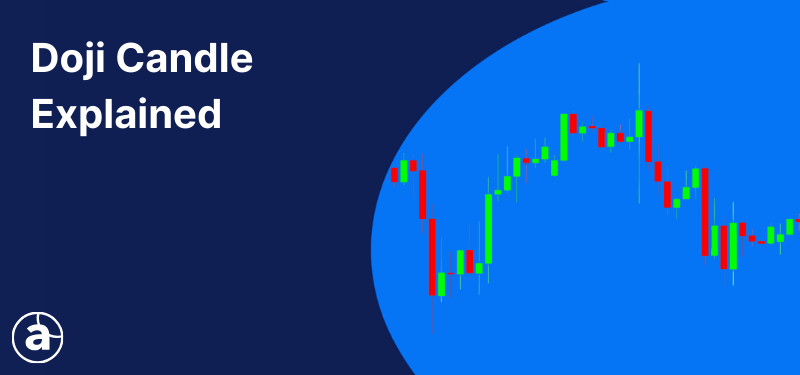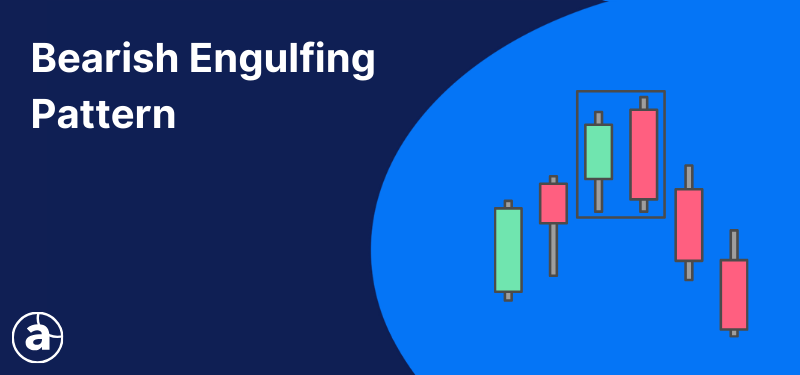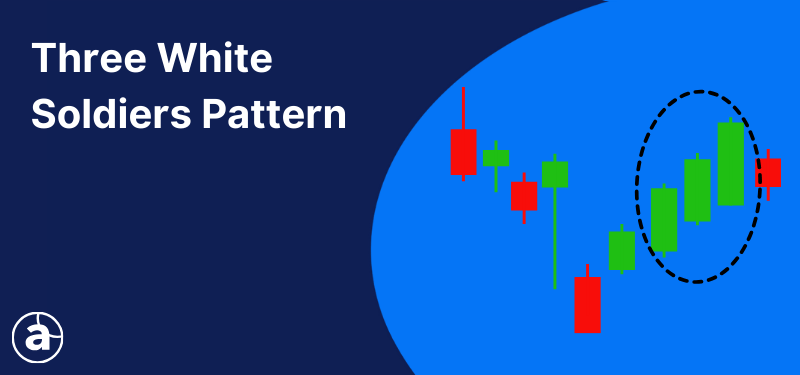Bullish Engulfing Pattern: A Comprehensive Guide for Traders
The bullish engulfing pattern is a candlestick pattern which can be used by traders to identify potential trading setups in the market. In this article, we will examine the pattern in detail, explain how it can be traded in conjunction with other technical analysis tools, what to consider before entering the market and much more!
The information in this article is provided for educational purposes only and does not constitute financial advice. Consult a financial advisor before making investment decisions.
Understanding the Bullish Engulfing Pattern
The bullish engulfing is a type of candlestick pattern which appears in a downtrend and signals a potential bullish reversal in price. Let's take a look at it in more detail.
Definition and Characteristics
The pattern comprises of two consecutive candles, the first of which is bearish and the second bullish.
The second, bullish, candle opens lower than the closing price of the first, bearish, candle and closes higher than its opening price. The visual effect of this is that the body of the second candle completely engulfs the body of the first candle, as highlighted in the image below.
Identifying the Pattern
Following a downward trend, the appearance of a bullish engulfing pattern implies that sentiment may have shifted. Even though sellers had control of the market when the second candle opened (evidenced by the downward gap), buyers took control, managed to drive price up and recovered all the losses from the previous session.
This indicates that the downward movement may have lost momentum and that buyers may be about to take the initiative.
Like many candlestick patterns, the bullish engulfing is easy to spot. Below is an example of the pattern occurring on an hourly chart of the GBPUSD currency pair.
As we can see, before its appearance, a downward trend had been in progress. Following its formation, sentiment appears to shift, and price begins an upward movement.
Trading Strategy Using Bullish Engulfing
There are many different ways traders can choose to trade this pattern. An aggressive trader may choose to enter the market as soon as the bullish engulfing candle closes, in anticipation that the upward momentum will continue.
However, as with other candlestick patterns, the bullish engulfing produces plenty of false signals. Consequently, it is prudent to look for further confirmation of a reversal in price before taking a position.
This might be done by waiting to see what happens in the following sessions, analysing historic support and resistance levels or by using technical indicators.
Using Bullish Engulfing as a Trading Signal
Let’s look at an example of how traders can use technical indicators to attempt to confirm the bullish engulfing’s reversal signal.
There are a number of indicators which can be used for this purpose, including the Relative Strength Index (RSI), Stochastic Oscillator and the Commodity Channel Index (CCI).
Below we’ve zoomed in to the same hourly GBPUSD chart as above and, this time, added the RSI indicator.
In the chart, we can see that, during the build-up to the formation of the pattern, the price of GBPUSD and the RSI indicator begin moving in different directions.
Whilst the GBPUSD was recording lower lows, the RSI began moving upwards. This is known as divergence, which is also a signal of a potential reversal in price. Consequently, traders might interpret the divergence as additional confirmation of the signal provided by the engulfing pattern.
Entry and Exit Points
When trading the bullish engulfing pattern, the specific entry and exit points will depend on the trader in question.
As we mentioned earlier, aggressive traders may choose to enter the market at the close of the engulfing candle. Others may choose to wait to see what happens in the following session before taking a position.
Again, in terms of a market exit, this pattern doesn’t provide specific target levels. A trader may identify an exit point using technical indicators, analysing previous support and resistance levels or by identifying bearish candlestick patterns that may indicate sentiment is changing once again.
Risk Management Techniques
Even with additional confirmation, candlestick patterns can produce many false signals. That's why it is crucial for traders to always practice good risk management when trading.
That includes setting a stop loss to help minimise losses if the market moves against you and never risking too much on any one trade.
Applying Bullish Engulfing in the Stock Market
The bullish engulfing pattern, and other candlestick patterns, can occur on any asset’s price chart. Let’s take a look at a couple of examples of this pattern occurring on the price charts of FTSE 100 stocks. In each case, we will include examples of indicators that can be used to show additional confirmation of a potential reversal.
Examples in the FTSE 100
Below is an hourly chart of UK alcohol giant Diageo with the Commodity Channel Index (CCI) added. In it we can see that, following a downward price movement, the bullish engulfing pattern appears.
In the build-up to its formation, divergence occurs between Diageo’s price and the CCI indicator, providing further evidence of a potential reversal. Sure enough, after the engulfing candles formation, price begins to trend upwards.
Another example below shows an hourly chart of UK bank Lloyds with the Stochastic Oscillator added. Again, following a downtrend, the bullish engulfing pattern appears. Further evidence of a potential reversal is provided by divergence between Lloyds’ price and the Stochastic Oscillator.
Technical Analysis Tools and Indicators to Use with Bullish Engulfing
We’ve already stressed the importance of seeking additional confirmation of a price reversal when trading the bullish engulfing pattern and examined a few ways of doing this. Let’s take a look at some of the other methods.
Common Indicators Used with Bullish Engulfing
There are many technical indicators which can be used to complement a bullish engulfing trading strategy. We’ve already looked at oscillators such as the CCI, RSI and the Stochastic Oscillator – let's now take a look at using the moving average indicator.
Moving Averages
Moving average indicators can smooth out price data and help traders identify the existence of trends and the beginning of new ones.
One method of identifying a change in trend is by using two moving averages (MAs): a shorter-term MA and a longer-term MA. When the shorter-term MA crosses above or below the longer-term MA, it indicates a potential change in the direction of the trend.
This method of identifying a change in trend could be used by traders to help confirm the signal provided by a bullish engulfing pattern.
The chart below is the same hourly chart of Diageo as displayed in the previous section. This time, we have added a 20-period MA (white) and a 50-period MA (red).
We can see that, following the appearance of the bullish engulfing pattern, the shorter MA crosses above the longer MA, indicating that the trend may be changing. This crossover could be interpreted as a signal to enter a long position.
However, a potential issue with this approach is the fact that moving averages take time to reflect a change in trend. As we can see above, the shorter-term MA does not cross above the longer-term MA for a number of sessions after the appearance of the bullish engulfing pattern. This could result in traders missing a significant portion, or even all, of the upward movement.
Support and Resistance Levels
Instead of, or in addition to, technical indicators traders may choose to analyse historic areas of support and resistance to help trade the bullish engulfing candlestick pattern.
Bullish engulfing patterns may have more significance if they occur at a historic area of support, as this has acted as a "floor" for an asset's price in the past. Similarly, if the engulfing candle, or the following move, breaks through an area of resistance it may serve as additional confirmation of a change in sentiment and a bullish reversal.
For example, at the beginning of the article we looked at a bullish engulfing pattern which occurred on the hourly chart of the GBPUSD currency pair. If we had analysed areas of historic support, we would have found that the bullish engulfing pattern actually occurred at an area which had provided support to GBPUSD over the preceding month.
The four-hour chart of GBPUSD below shows this area of horizontal support, which price bounced off on three occasions in the month prior to the bullish engulfing.
Chart Patterns
Another option for traders when trading the bullish engulfing pattern is to look for other bullish patterns which might serve as additional confirmation of the change in sentiment. To learn about a range of other chart and candlestick patterns which occur in the financial markets, check out our other educational articles.
Conclusion
The bullish engulfing pattern signals a potential bullish reversal. The pattern consists of a bearish candle followed by a bullish candle, where the body of the bullish candle completely engulfs the body of the preceding bearish candle.
To help filter out false signals, traders should seek additional confirmation of a reversal before entering the market. This can be done using technical indicators, looking for additional bullish candlestick patterns or analysing historical support and resistance levels.
However, it is important to remember that, even with additional confirmation, there is no way of ensuring success when trading candlestick patterns. All trading involves risk, which is why it is important to practice good risk management when trading.
INFORMATION ABOUT ANALYTICAL MATERIALS:
The given data provides additional information regarding all analysis, estimates, prognosis, forecasts, market reviews, weekly outlooks or other similar assessments or information (hereinafter “Analysis”) published on the websites of Admiral Markets investment firms operating under the Admiral Markets trademark (hereinafter “Admiral Markets”) Before making any investment decisions please pay close attention to the following:
- This is a marketing communication. The content is published for informative purposes only and is in no way to be construed as investment advice or recommendation. It has not been prepared in accordance with legal requirements designed to promote the independence of investment research, and that it is not subject to any prohibition on dealing ahead of the dissemination of investment research.
- Any investment decision is made by each client alone whereas Admiral Markets shall not be responsible for any loss or damage arising from any such decision, whether or not based on the content.
- With view to protecting the interests of our clients and the objectivity of the Analysis, Admiral Markets has established relevant internal procedures for prevention and management of conflicts of interest.
- The Analysis is prepared by an analyst (hereinafter “Author”). The Author Roberto Rivero is a contractor for Admiral Markets. This content is a marketing communication and does not constitute independent financial research.
- Whilst every reasonable effort is taken to ensure that all sources of the content are reliable and that all information is presented, as much as possible, in an understandable, timely, precise and complete manner, Admiral Markets does not guarantee the accuracy or completeness of any information contained within the Analysis.
- Any kind of past or modelled performance of financial instruments indicated within the content should not be construed as an express or implied promise, guarantee or implication by Admiral Markets for any future performance. The value of the financial instrument may both increase and decrease and the preservation of the asset value is not guaranteed.
- Leveraged products (including contracts for difference) are speculative in nature and may result in losses or profit. Before you start trading, please ensure that you fully understand the risks involved.













